HI6006 Group Report: Analyzing Carlsberg's Competitive Strategy
VerifiedAdded on 2022/12/14
|12
|3079
|53
Report
AI Summary
This report provides a comprehensive analysis of Carlsberg's competitive strategy. It begins with a brief overview of the company's history and its position in the brewing industry. The report then identifies key strategic issues, including an examination of the political, economic, social, and technological environments using PEST analysis. Competitive dynamics are explored through a SWOT analysis, highlighting the company's strengths, weaknesses, opportunities, and threats. Relevant theoretical concepts, such as the Ansoff Matrix and Porter's Five Forces, are applied to assess Carlsberg's market penetration, development, product development, and diversification strategies. The marketing mix of Carlsberg, including product, place, price, and promotion, is also thoroughly examined. The report concludes with a summary of findings and recommendations based on the analysis.

Running Head: ANALYSING COMPETITIVE STRATEGY OF CARLSBERG
ANALYSING COMPETITIVE STRATEGY OF CARLSBERG
Name of the Student:
Name of the University
Author Note
ANALYSING COMPETITIVE STRATEGY OF CARLSBERG
Name of the Student:
Name of the University
Author Note
Paraphrase This Document
Need a fresh take? Get an instant paraphrase of this document with our AI Paraphraser

1ANALYSING COMPETITIVE STRATEGY OF CARLSBERG
EXECUTIVE SUMMARY
Carlsberg is a leading brewery agency that has a global acknowledgement. The aim
of this paper is to analyse the case study of this particular company. A brief history of
the company is purposefully given to trace the progress of Carlsberg from the
beginning till now. The paper elaborates the business strategy applied by Carlsberg
in order to reach the desired goal. The study describes competitive dynamics to
understand the strength, weakness, opportunity, and threat for the growth of the
business. Additionally, the paper reflects on the relevant model of Ansoff Matrix to
determine the productivity of the Carlsberg Group.
EXECUTIVE SUMMARY
Carlsberg is a leading brewery agency that has a global acknowledgement. The aim
of this paper is to analyse the case study of this particular company. A brief history of
the company is purposefully given to trace the progress of Carlsberg from the
beginning till now. The paper elaborates the business strategy applied by Carlsberg
in order to reach the desired goal. The study describes competitive dynamics to
understand the strength, weakness, opportunity, and threat for the growth of the
business. Additionally, the paper reflects on the relevant model of Ansoff Matrix to
determine the productivity of the Carlsberg Group.
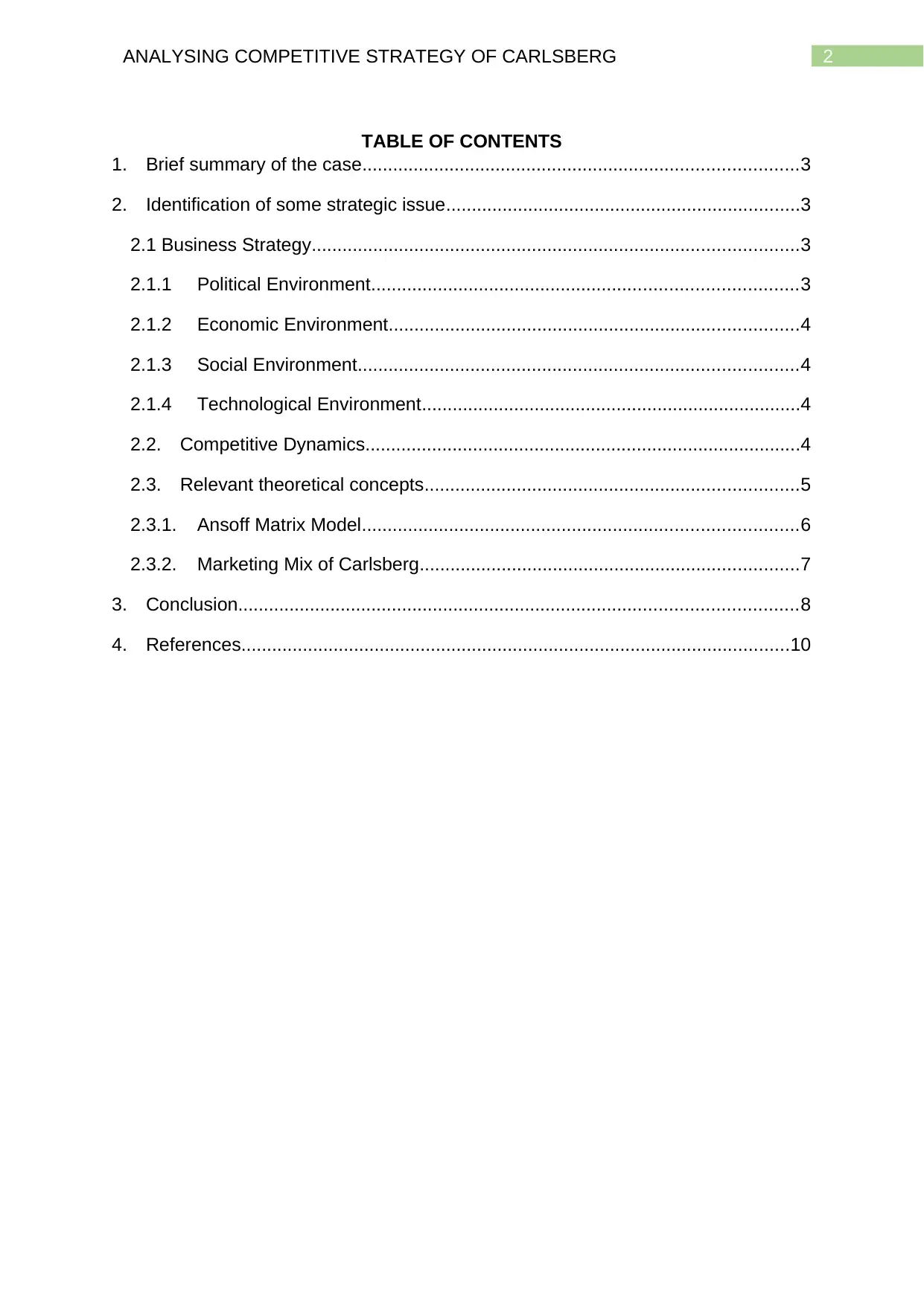
2ANALYSING COMPETITIVE STRATEGY OF CARLSBERG
TABLE OF CONTENTS
1. Brief summary of the case.....................................................................................3
2. Identification of some strategic issue.....................................................................3
2.1 Business Strategy...............................................................................................3
2.1.1 Political Environment...................................................................................3
2.1.2 Economic Environment................................................................................4
2.1.3 Social Environment......................................................................................4
2.1.4 Technological Environment..........................................................................4
2.2. Competitive Dynamics.....................................................................................4
2.3. Relevant theoretical concepts.........................................................................5
2.3.1. Ansoff Matrix Model.....................................................................................6
2.3.2. Marketing Mix of Carlsberg..........................................................................7
3. Conclusion.............................................................................................................8
4. References...........................................................................................................10
TABLE OF CONTENTS
1. Brief summary of the case.....................................................................................3
2. Identification of some strategic issue.....................................................................3
2.1 Business Strategy...............................................................................................3
2.1.1 Political Environment...................................................................................3
2.1.2 Economic Environment................................................................................4
2.1.3 Social Environment......................................................................................4
2.1.4 Technological Environment..........................................................................4
2.2. Competitive Dynamics.....................................................................................4
2.3. Relevant theoretical concepts.........................................................................5
2.3.1. Ansoff Matrix Model.....................................................................................6
2.3.2. Marketing Mix of Carlsberg..........................................................................7
3. Conclusion.............................................................................................................8
4. References...........................................................................................................10
⊘ This is a preview!⊘
Do you want full access?
Subscribe today to unlock all pages.

Trusted by 1+ million students worldwide
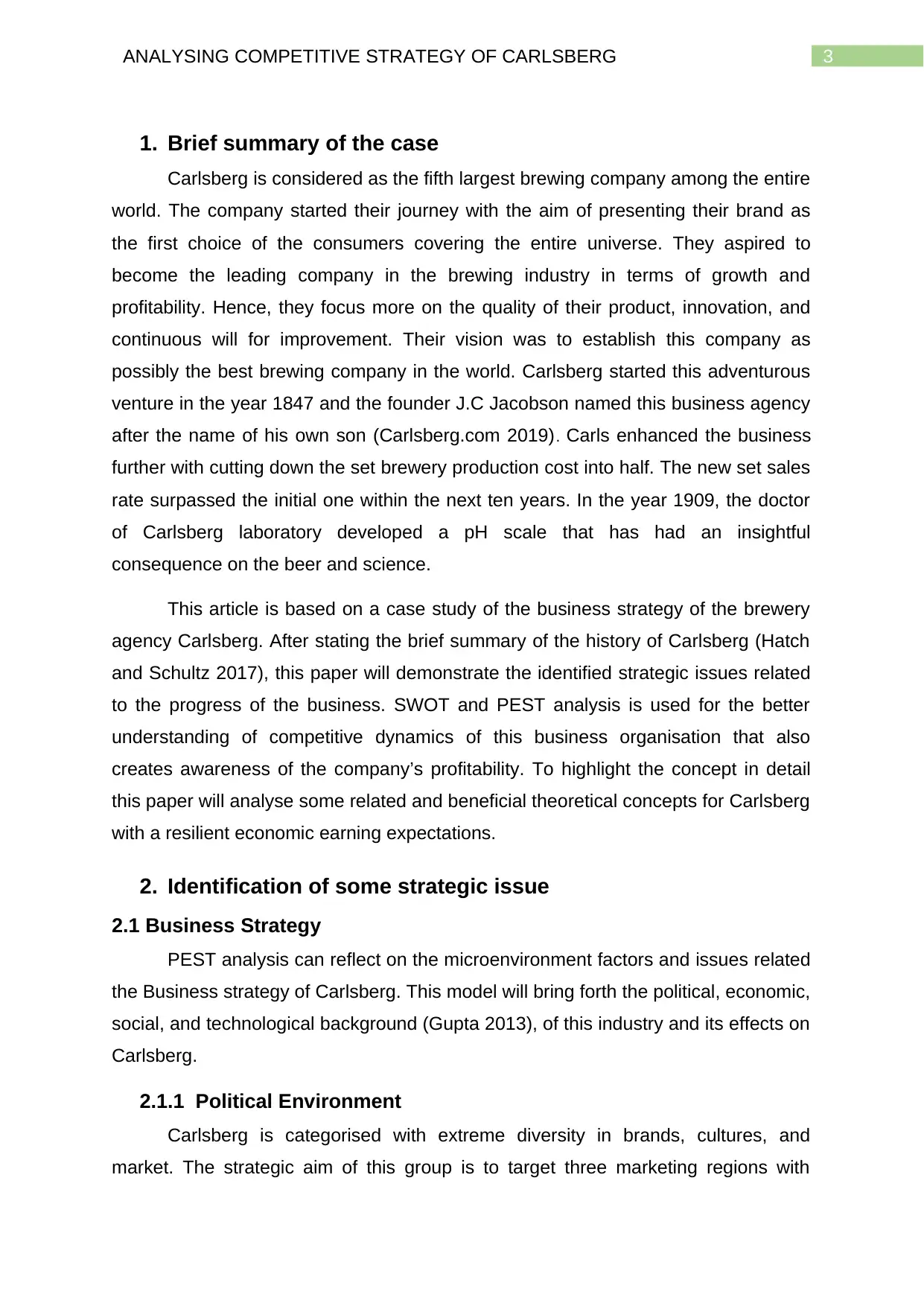
3ANALYSING COMPETITIVE STRATEGY OF CARLSBERG
1. Brief summary of the case
Carlsberg is considered as the fifth largest brewing company among the entire
world. The company started their journey with the aim of presenting their brand as
the first choice of the consumers covering the entire universe. They aspired to
become the leading company in the brewing industry in terms of growth and
profitability. Hence, they focus more on the quality of their product, innovation, and
continuous will for improvement. Their vision was to establish this company as
possibly the best brewing company in the world. Carlsberg started this adventurous
venture in the year 1847 and the founder J.C Jacobson named this business agency
after the name of his own son (Carlsberg.com 2019). Carls enhanced the business
further with cutting down the set brewery production cost into half. The new set sales
rate surpassed the initial one within the next ten years. In the year 1909, the doctor
of Carlsberg laboratory developed a pH scale that has had an insightful
consequence on the beer and science.
This article is based on a case study of the business strategy of the brewery
agency Carlsberg. After stating the brief summary of the history of Carlsberg (Hatch
and Schultz 2017), this paper will demonstrate the identified strategic issues related
to the progress of the business. SWOT and PEST analysis is used for the better
understanding of competitive dynamics of this business organisation that also
creates awareness of the company’s profitability. To highlight the concept in detail
this paper will analyse some related and beneficial theoretical concepts for Carlsberg
with a resilient economic earning expectations.
2. Identification of some strategic issue
2.1 Business Strategy
PEST analysis can reflect on the microenvironment factors and issues related
the Business strategy of Carlsberg. This model will bring forth the political, economic,
social, and technological background (Gupta 2013), of this industry and its effects on
Carlsberg.
2.1.1 Political Environment
Carlsberg is categorised with extreme diversity in brands, cultures, and
market. The strategic aim of this group is to target three marketing regions with
1. Brief summary of the case
Carlsberg is considered as the fifth largest brewing company among the entire
world. The company started their journey with the aim of presenting their brand as
the first choice of the consumers covering the entire universe. They aspired to
become the leading company in the brewing industry in terms of growth and
profitability. Hence, they focus more on the quality of their product, innovation, and
continuous will for improvement. Their vision was to establish this company as
possibly the best brewing company in the world. Carlsberg started this adventurous
venture in the year 1847 and the founder J.C Jacobson named this business agency
after the name of his own son (Carlsberg.com 2019). Carls enhanced the business
further with cutting down the set brewery production cost into half. The new set sales
rate surpassed the initial one within the next ten years. In the year 1909, the doctor
of Carlsberg laboratory developed a pH scale that has had an insightful
consequence on the beer and science.
This article is based on a case study of the business strategy of the brewery
agency Carlsberg. After stating the brief summary of the history of Carlsberg (Hatch
and Schultz 2017), this paper will demonstrate the identified strategic issues related
to the progress of the business. SWOT and PEST analysis is used for the better
understanding of competitive dynamics of this business organisation that also
creates awareness of the company’s profitability. To highlight the concept in detail
this paper will analyse some related and beneficial theoretical concepts for Carlsberg
with a resilient economic earning expectations.
2. Identification of some strategic issue
2.1 Business Strategy
PEST analysis can reflect on the microenvironment factors and issues related
the Business strategy of Carlsberg. This model will bring forth the political, economic,
social, and technological background (Gupta 2013), of this industry and its effects on
Carlsberg.
2.1.1 Political Environment
Carlsberg is categorised with extreme diversity in brands, cultures, and
market. The strategic aim of this group is to target three marketing regions with
Paraphrase This Document
Need a fresh take? Get an instant paraphrase of this document with our AI Paraphraser

4ANALYSING COMPETITIVE STRATEGY OF CARLSBERG
which the company competes. In general, the beer industry is highly depended on
the taxation regulations (Popescu and Losim 2015). Carlsberg requires obeying both
the federal and state government to make the production, distribution, and marketing
of their products legal (Fotis and Zevgolis 2016). Legalisation is important from
labelling to distributing the products throughout the world.
2.1.2 Economic Environment
The economic environment of brewery industry is segmented into three
categories namely national, microbrewers, and regional. National level brewers are
high scale business agency as Heineken. On the other hand, Carlsberg is
considered as a regional brewer as they target some specific states. It is worth
mentioning in this regard that Carlsberg shares the philosophy of Heineken that
states enhanced profitability through revolution and streamline (Niero and Rivera
2018).
2.1.3 Social Environment
The beer industry faces adversity in attaining public opinion, which has a
direct impact on generating sales. Studies have shown that alcohol reacts adversely
in human body. People are becoming more health conscious and avoiding alcohol
beverages for the same reason. Hence, brewing agencies are more focusing on
producing lighter products (Verde 2015).
2.1.4 Technological Environment
Beer industry depends on technology to manage and develop distribution
channels. Carlsberg is utilising information technology (Howard 2014) to accelerate
the production. The recent innovative beer product of Carlsberg is Jacobsen Lager
beer.
2.2. Competitive Dynamics
The beer industry is facing some ongoing dynamics that directs to some
opportunities and threats (Lakka et al., 2013). A significant SWOT analysis will
demonstrate the competitive dynamics of Carlsberg. SWOT model will elaborate the
strength, weaknesses, opportunities, and threats for this particular brand.
Strength
which the company competes. In general, the beer industry is highly depended on
the taxation regulations (Popescu and Losim 2015). Carlsberg requires obeying both
the federal and state government to make the production, distribution, and marketing
of their products legal (Fotis and Zevgolis 2016). Legalisation is important from
labelling to distributing the products throughout the world.
2.1.2 Economic Environment
The economic environment of brewery industry is segmented into three
categories namely national, microbrewers, and regional. National level brewers are
high scale business agency as Heineken. On the other hand, Carlsberg is
considered as a regional brewer as they target some specific states. It is worth
mentioning in this regard that Carlsberg shares the philosophy of Heineken that
states enhanced profitability through revolution and streamline (Niero and Rivera
2018).
2.1.3 Social Environment
The beer industry faces adversity in attaining public opinion, which has a
direct impact on generating sales. Studies have shown that alcohol reacts adversely
in human body. People are becoming more health conscious and avoiding alcohol
beverages for the same reason. Hence, brewing agencies are more focusing on
producing lighter products (Verde 2015).
2.1.4 Technological Environment
Beer industry depends on technology to manage and develop distribution
channels. Carlsberg is utilising information technology (Howard 2014) to accelerate
the production. The recent innovative beer product of Carlsberg is Jacobsen Lager
beer.
2.2. Competitive Dynamics
The beer industry is facing some ongoing dynamics that directs to some
opportunities and threats (Lakka et al., 2013). A significant SWOT analysis will
demonstrate the competitive dynamics of Carlsberg. SWOT model will elaborate the
strength, weaknesses, opportunities, and threats for this particular brand.
Strength
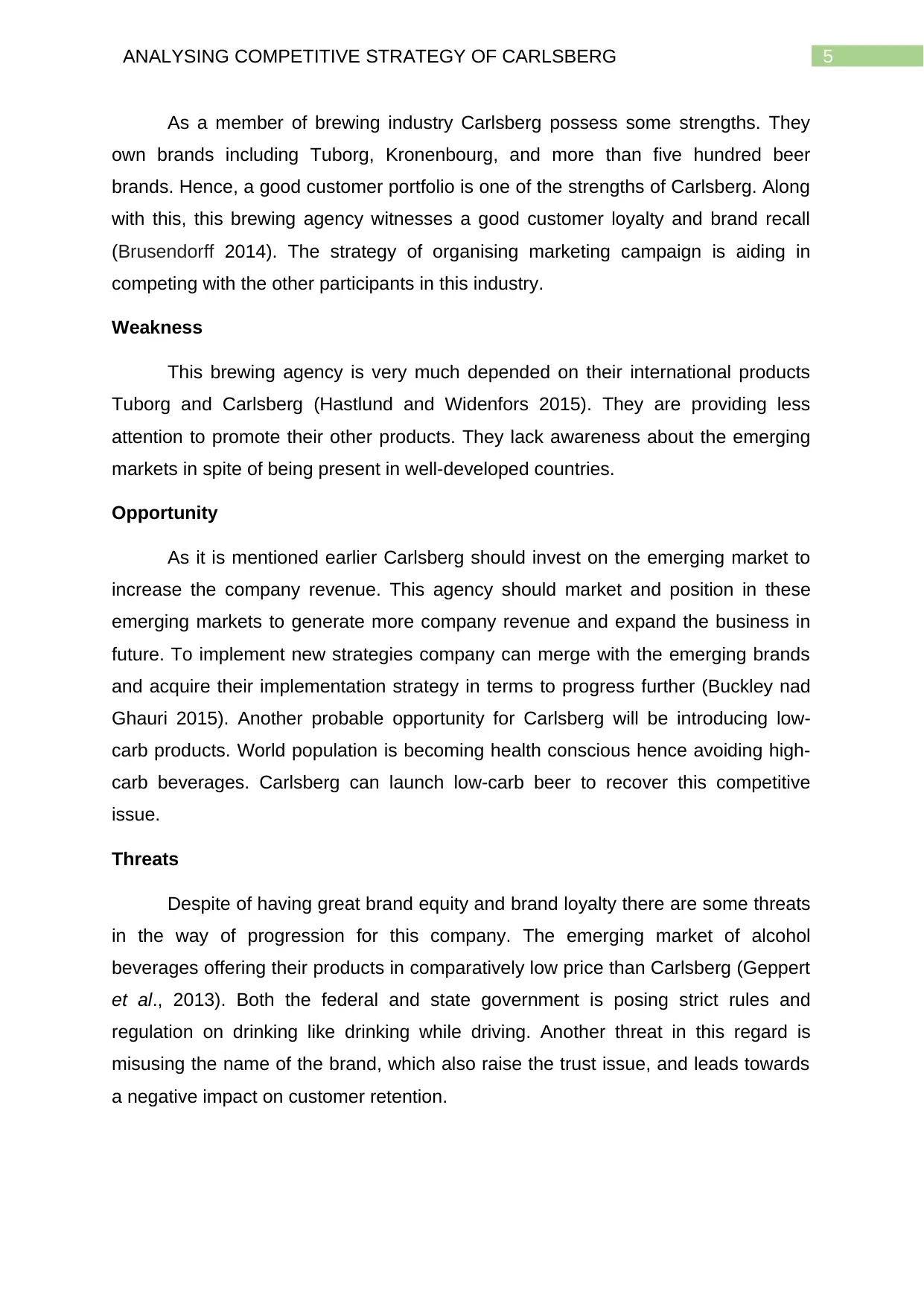
5ANALYSING COMPETITIVE STRATEGY OF CARLSBERG
As a member of brewing industry Carlsberg possess some strengths. They
own brands including Tuborg, Kronenbourg, and more than five hundred beer
brands. Hence, a good customer portfolio is one of the strengths of Carlsberg. Along
with this, this brewing agency witnesses a good customer loyalty and brand recall
(Brusendorff 2014). The strategy of organising marketing campaign is aiding in
competing with the other participants in this industry.
Weakness
This brewing agency is very much depended on their international products
Tuborg and Carlsberg (Hastlund and Widenfors 2015). They are providing less
attention to promote their other products. They lack awareness about the emerging
markets in spite of being present in well-developed countries.
Opportunity
As it is mentioned earlier Carlsberg should invest on the emerging market to
increase the company revenue. This agency should market and position in these
emerging markets to generate more company revenue and expand the business in
future. To implement new strategies company can merge with the emerging brands
and acquire their implementation strategy in terms to progress further (Buckley nad
Ghauri 2015). Another probable opportunity for Carlsberg will be introducing low-
carb products. World population is becoming health conscious hence avoiding high-
carb beverages. Carlsberg can launch low-carb beer to recover this competitive
issue.
Threats
Despite of having great brand equity and brand loyalty there are some threats
in the way of progression for this company. The emerging market of alcohol
beverages offering their products in comparatively low price than Carlsberg (Geppert
et al., 2013). Both the federal and state government is posing strict rules and
regulation on drinking like drinking while driving. Another threat in this regard is
misusing the name of the brand, which also raise the trust issue, and leads towards
a negative impact on customer retention.
As a member of brewing industry Carlsberg possess some strengths. They
own brands including Tuborg, Kronenbourg, and more than five hundred beer
brands. Hence, a good customer portfolio is one of the strengths of Carlsberg. Along
with this, this brewing agency witnesses a good customer loyalty and brand recall
(Brusendorff 2014). The strategy of organising marketing campaign is aiding in
competing with the other participants in this industry.
Weakness
This brewing agency is very much depended on their international products
Tuborg and Carlsberg (Hastlund and Widenfors 2015). They are providing less
attention to promote their other products. They lack awareness about the emerging
markets in spite of being present in well-developed countries.
Opportunity
As it is mentioned earlier Carlsberg should invest on the emerging market to
increase the company revenue. This agency should market and position in these
emerging markets to generate more company revenue and expand the business in
future. To implement new strategies company can merge with the emerging brands
and acquire their implementation strategy in terms to progress further (Buckley nad
Ghauri 2015). Another probable opportunity for Carlsberg will be introducing low-
carb products. World population is becoming health conscious hence avoiding high-
carb beverages. Carlsberg can launch low-carb beer to recover this competitive
issue.
Threats
Despite of having great brand equity and brand loyalty there are some threats
in the way of progression for this company. The emerging market of alcohol
beverages offering their products in comparatively low price than Carlsberg (Geppert
et al., 2013). Both the federal and state government is posing strict rules and
regulation on drinking like drinking while driving. Another threat in this regard is
misusing the name of the brand, which also raise the trust issue, and leads towards
a negative impact on customer retention.
⊘ This is a preview!⊘
Do you want full access?
Subscribe today to unlock all pages.

Trusted by 1+ million students worldwide
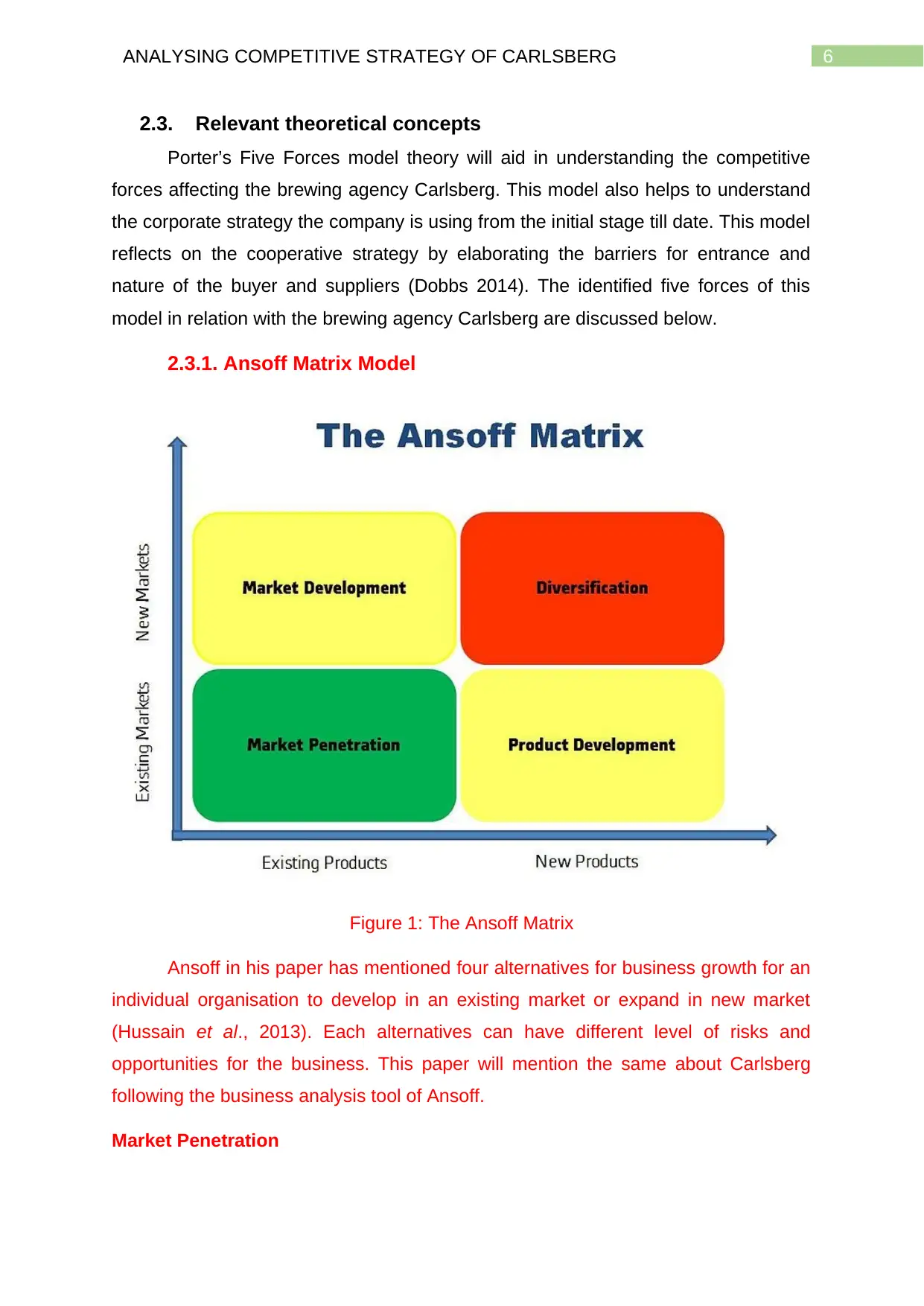
6ANALYSING COMPETITIVE STRATEGY OF CARLSBERG
2.3. Relevant theoretical concepts
Porter’s Five Forces model theory will aid in understanding the competitive
forces affecting the brewing agency Carlsberg. This model also helps to understand
the corporate strategy the company is using from the initial stage till date. This model
reflects on the cooperative strategy by elaborating the barriers for entrance and
nature of the buyer and suppliers (Dobbs 2014). The identified five forces of this
model in relation with the brewing agency Carlsberg are discussed below.
2.3.1. Ansoff Matrix Model
Figure 1: The Ansoff Matrix
Ansoff in his paper has mentioned four alternatives for business growth for an
individual organisation to develop in an existing market or expand in new market
(Hussain et al., 2013). Each alternatives can have different level of risks and
opportunities for the business. This paper will mention the same about Carlsberg
following the business analysis tool of Ansoff.
Market Penetration
2.3. Relevant theoretical concepts
Porter’s Five Forces model theory will aid in understanding the competitive
forces affecting the brewing agency Carlsberg. This model also helps to understand
the corporate strategy the company is using from the initial stage till date. This model
reflects on the cooperative strategy by elaborating the barriers for entrance and
nature of the buyer and suppliers (Dobbs 2014). The identified five forces of this
model in relation with the brewing agency Carlsberg are discussed below.
2.3.1. Ansoff Matrix Model
Figure 1: The Ansoff Matrix
Ansoff in his paper has mentioned four alternatives for business growth for an
individual organisation to develop in an existing market or expand in new market
(Hussain et al., 2013). Each alternatives can have different level of risks and
opportunities for the business. This paper will mention the same about Carlsberg
following the business analysis tool of Ansoff.
Market Penetration
Paraphrase This Document
Need a fresh take? Get an instant paraphrase of this document with our AI Paraphraser
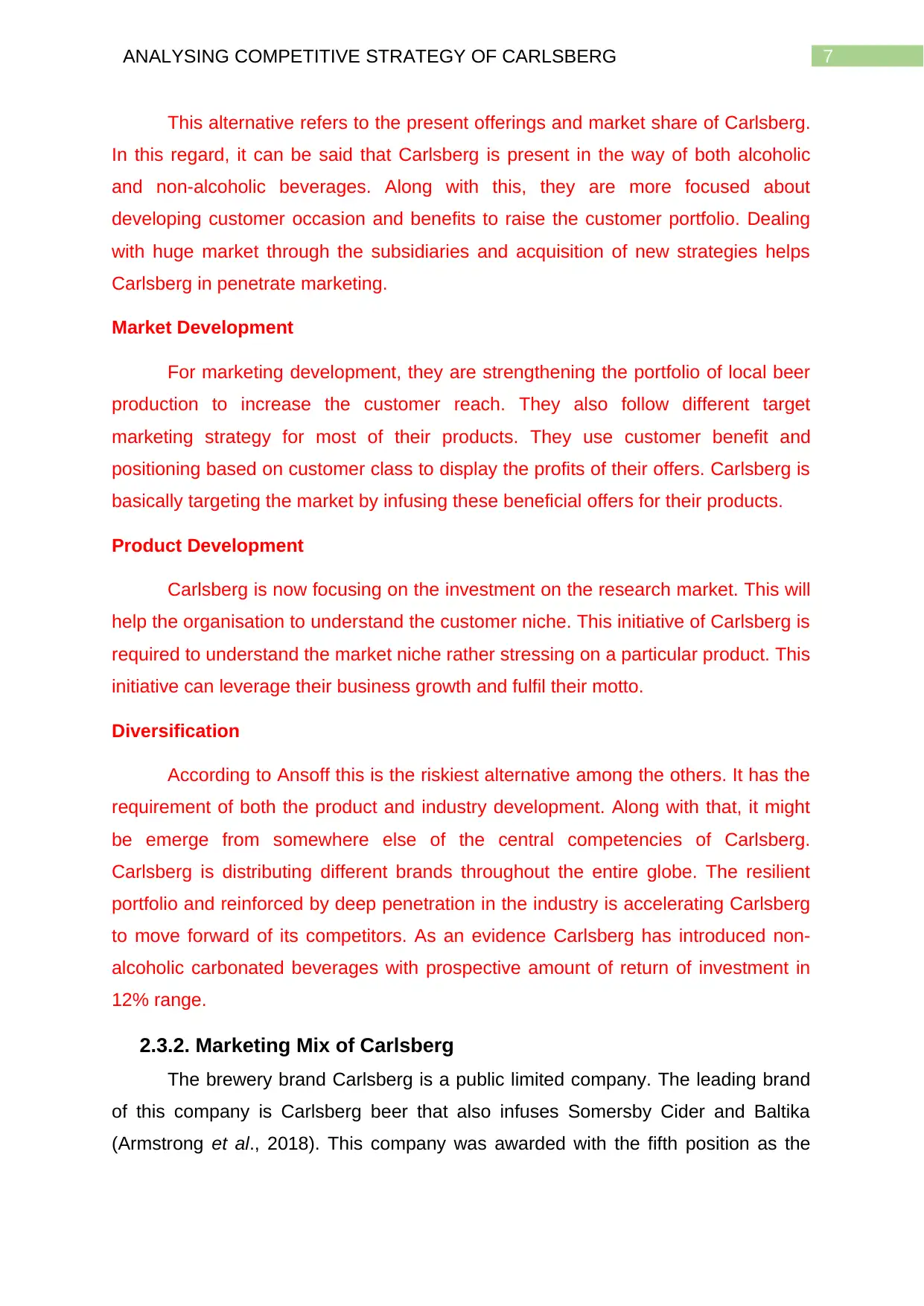
7ANALYSING COMPETITIVE STRATEGY OF CARLSBERG
This alternative refers to the present offerings and market share of Carlsberg.
In this regard, it can be said that Carlsberg is present in the way of both alcoholic
and non-alcoholic beverages. Along with this, they are more focused about
developing customer occasion and benefits to raise the customer portfolio. Dealing
with huge market through the subsidiaries and acquisition of new strategies helps
Carlsberg in penetrate marketing.
Market Development
For marketing development, they are strengthening the portfolio of local beer
production to increase the customer reach. They also follow different target
marketing strategy for most of their products. They use customer benefit and
positioning based on customer class to display the profits of their offers. Carlsberg is
basically targeting the market by infusing these beneficial offers for their products.
Product Development
Carlsberg is now focusing on the investment on the research market. This will
help the organisation to understand the customer niche. This initiative of Carlsberg is
required to understand the market niche rather stressing on a particular product. This
initiative can leverage their business growth and fulfil their motto.
Diversification
According to Ansoff this is the riskiest alternative among the others. It has the
requirement of both the product and industry development. Along with that, it might
be emerge from somewhere else of the central competencies of Carlsberg.
Carlsberg is distributing different brands throughout the entire globe. The resilient
portfolio and reinforced by deep penetration in the industry is accelerating Carlsberg
to move forward of its competitors. As an evidence Carlsberg has introduced non-
alcoholic carbonated beverages with prospective amount of return of investment in
12% range.
2.3.2. Marketing Mix of Carlsberg
The brewery brand Carlsberg is a public limited company. The leading brand
of this company is Carlsberg beer that also infuses Somersby Cider and Baltika
(Armstrong et al., 2018). This company was awarded with the fifth position as the
This alternative refers to the present offerings and market share of Carlsberg.
In this regard, it can be said that Carlsberg is present in the way of both alcoholic
and non-alcoholic beverages. Along with this, they are more focused about
developing customer occasion and benefits to raise the customer portfolio. Dealing
with huge market through the subsidiaries and acquisition of new strategies helps
Carlsberg in penetrate marketing.
Market Development
For marketing development, they are strengthening the portfolio of local beer
production to increase the customer reach. They also follow different target
marketing strategy for most of their products. They use customer benefit and
positioning based on customer class to display the profits of their offers. Carlsberg is
basically targeting the market by infusing these beneficial offers for their products.
Product Development
Carlsberg is now focusing on the investment on the research market. This will
help the organisation to understand the customer niche. This initiative of Carlsberg is
required to understand the market niche rather stressing on a particular product. This
initiative can leverage their business growth and fulfil their motto.
Diversification
According to Ansoff this is the riskiest alternative among the others. It has the
requirement of both the product and industry development. Along with that, it might
be emerge from somewhere else of the central competencies of Carlsberg.
Carlsberg is distributing different brands throughout the entire globe. The resilient
portfolio and reinforced by deep penetration in the industry is accelerating Carlsberg
to move forward of its competitors. As an evidence Carlsberg has introduced non-
alcoholic carbonated beverages with prospective amount of return of investment in
12% range.
2.3.2. Marketing Mix of Carlsberg
The brewery brand Carlsberg is a public limited company. The leading brand
of this company is Carlsberg beer that also infuses Somersby Cider and Baltika
(Armstrong et al., 2018). This company was awarded with the fifth position as the
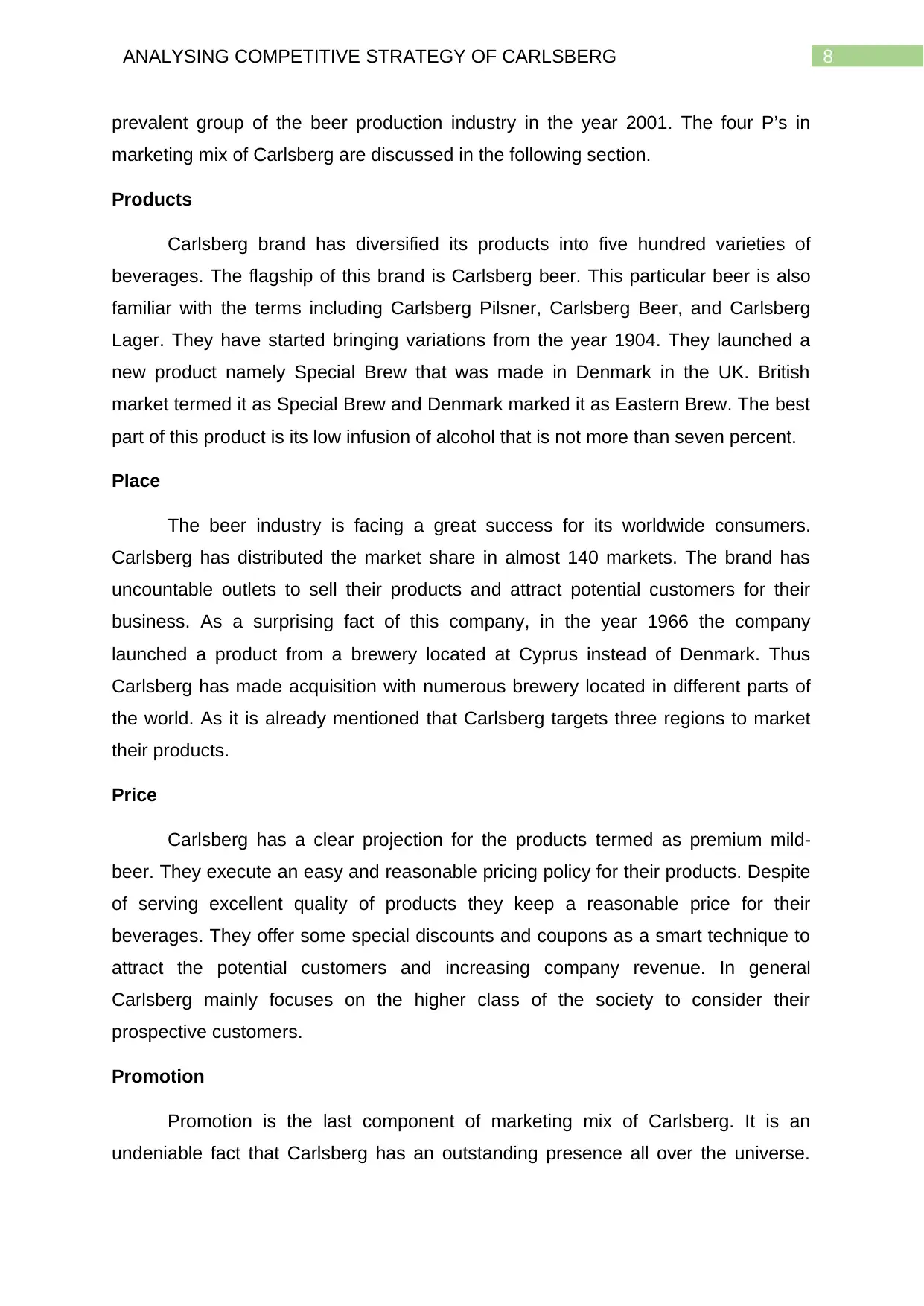
8ANALYSING COMPETITIVE STRATEGY OF CARLSBERG
prevalent group of the beer production industry in the year 2001. The four P’s in
marketing mix of Carlsberg are discussed in the following section.
Products
Carlsberg brand has diversified its products into five hundred varieties of
beverages. The flagship of this brand is Carlsberg beer. This particular beer is also
familiar with the terms including Carlsberg Pilsner, Carlsberg Beer, and Carlsberg
Lager. They have started bringing variations from the year 1904. They launched a
new product namely Special Brew that was made in Denmark in the UK. British
market termed it as Special Brew and Denmark marked it as Eastern Brew. The best
part of this product is its low infusion of alcohol that is not more than seven percent.
Place
The beer industry is facing a great success for its worldwide consumers.
Carlsberg has distributed the market share in almost 140 markets. The brand has
uncountable outlets to sell their products and attract potential customers for their
business. As a surprising fact of this company, in the year 1966 the company
launched a product from a brewery located at Cyprus instead of Denmark. Thus
Carlsberg has made acquisition with numerous brewery located in different parts of
the world. As it is already mentioned that Carlsberg targets three regions to market
their products.
Price
Carlsberg has a clear projection for the products termed as premium mild-
beer. They execute an easy and reasonable pricing policy for their products. Despite
of serving excellent quality of products they keep a reasonable price for their
beverages. They offer some special discounts and coupons as a smart technique to
attract the potential customers and increasing company revenue. In general
Carlsberg mainly focuses on the higher class of the society to consider their
prospective customers.
Promotion
Promotion is the last component of marketing mix of Carlsberg. It is an
undeniable fact that Carlsberg has an outstanding presence all over the universe.
prevalent group of the beer production industry in the year 2001. The four P’s in
marketing mix of Carlsberg are discussed in the following section.
Products
Carlsberg brand has diversified its products into five hundred varieties of
beverages. The flagship of this brand is Carlsberg beer. This particular beer is also
familiar with the terms including Carlsberg Pilsner, Carlsberg Beer, and Carlsberg
Lager. They have started bringing variations from the year 1904. They launched a
new product namely Special Brew that was made in Denmark in the UK. British
market termed it as Special Brew and Denmark marked it as Eastern Brew. The best
part of this product is its low infusion of alcohol that is not more than seven percent.
Place
The beer industry is facing a great success for its worldwide consumers.
Carlsberg has distributed the market share in almost 140 markets. The brand has
uncountable outlets to sell their products and attract potential customers for their
business. As a surprising fact of this company, in the year 1966 the company
launched a product from a brewery located at Cyprus instead of Denmark. Thus
Carlsberg has made acquisition with numerous brewery located in different parts of
the world. As it is already mentioned that Carlsberg targets three regions to market
their products.
Price
Carlsberg has a clear projection for the products termed as premium mild-
beer. They execute an easy and reasonable pricing policy for their products. Despite
of serving excellent quality of products they keep a reasonable price for their
beverages. They offer some special discounts and coupons as a smart technique to
attract the potential customers and increasing company revenue. In general
Carlsberg mainly focuses on the higher class of the society to consider their
prospective customers.
Promotion
Promotion is the last component of marketing mix of Carlsberg. It is an
undeniable fact that Carlsberg has an outstanding presence all over the universe.
⊘ This is a preview!⊘
Do you want full access?
Subscribe today to unlock all pages.

Trusted by 1+ million students worldwide

9ANALYSING COMPETITIVE STRATEGY OF CARLSBERG
The acquired policies for marketing, branding, and advertising the products are
outstanding and revenue generating at the same point of view (Verde 2015). The
variation they have recently launched namely mild beer attracted the young
generation mainly. Carlsberg believes in reinventing new policies for the promotion
of the brand. They also advertise through social media platforms, which is the best
way to reach to the ideal customers. To demonstrate it further it can be said that the
company is very much technology friendly and easily understands the psychology of
their ideal customers.
3. Conclusion
To conclude this entire paper, it can be said that Carlsberg displays an
outstanding performance record from the beginning of its journey. According to the
research Jacobson, the founder of this agency, set the name as most remarkable
brand in the brewery industry. According to this case study, Carl (son of Jacobson)
carried forward the company and brought the actual success for the company. To
analyse the business strategy of this company some strength and weaknesses have
been noticed. The strength are amazing brand recognition, customer loyalty, and
adopted strategies for further progress. However, the weaknesses of this agency are
increasing rate of the raw materials and the emergence of local brands as substitute
products. To overcome the weaknesses this study also demonstrated the probable
opportunities. The opportunities for this company continue their prestigious journey
are launching low-carb products and controlling the cost. However, theoretical
concepts for this brand has shown that Carlsberg business with reasonable price to
increase their availability for their customers.
Carlsberg has made this remarkable journey through continuous innovation
with differentiation. The company is very much focused in implementing each and
every strategies for the promotion. With these effective strategies, they became
successful in fulfilling the market and consumer’s niche. Producing local and
traditional beer is the main feature that is main responsible factor of this company’s
success. Along with this, the strategic management to handle the turbulence in the
existing market has positioned Carlsberg, as the largest brewing agency considering
the entire alcohol industry.
The acquired policies for marketing, branding, and advertising the products are
outstanding and revenue generating at the same point of view (Verde 2015). The
variation they have recently launched namely mild beer attracted the young
generation mainly. Carlsberg believes in reinventing new policies for the promotion
of the brand. They also advertise through social media platforms, which is the best
way to reach to the ideal customers. To demonstrate it further it can be said that the
company is very much technology friendly and easily understands the psychology of
their ideal customers.
3. Conclusion
To conclude this entire paper, it can be said that Carlsberg displays an
outstanding performance record from the beginning of its journey. According to the
research Jacobson, the founder of this agency, set the name as most remarkable
brand in the brewery industry. According to this case study, Carl (son of Jacobson)
carried forward the company and brought the actual success for the company. To
analyse the business strategy of this company some strength and weaknesses have
been noticed. The strength are amazing brand recognition, customer loyalty, and
adopted strategies for further progress. However, the weaknesses of this agency are
increasing rate of the raw materials and the emergence of local brands as substitute
products. To overcome the weaknesses this study also demonstrated the probable
opportunities. The opportunities for this company continue their prestigious journey
are launching low-carb products and controlling the cost. However, theoretical
concepts for this brand has shown that Carlsberg business with reasonable price to
increase their availability for their customers.
Carlsberg has made this remarkable journey through continuous innovation
with differentiation. The company is very much focused in implementing each and
every strategies for the promotion. With these effective strategies, they became
successful in fulfilling the market and consumer’s niche. Producing local and
traditional beer is the main feature that is main responsible factor of this company’s
success. Along with this, the strategic management to handle the turbulence in the
existing market has positioned Carlsberg, as the largest brewing agency considering
the entire alcohol industry.
Paraphrase This Document
Need a fresh take? Get an instant paraphrase of this document with our AI Paraphraser

10ANALYSING COMPETITIVE STRATEGY OF CARLSBERG
4. References
Armstrong, G.M., Kotler, P., Harker, M.J. and Brennan, R., 2018. Marketing: an
introduction. Pearson UK.
Brusendorff, A.S., 2014. Corporate Social Responsibility: A Case Study on
Carlsberg.
Buckley, P.J. and Ghauri, P. eds., 2015. International business strategy: theory and
practice. Routledge.
Carlsberg.com (2019). Carlsberg - Probably the best beer in the world. [online]
Carlsberg.com. Available at: https://www.carlsberg.com/en [Accessed 5 Sep. 2019].
Carol, Y.Z., Federico, G. and Thomas, M.B., 2015. Competitiveness in a saturated
market. A case study of the Scottish craft beer industry. International Journal of
Business and Social Science, 6(8).
E. Dobbs, M., 2014. Guidelines for applying Porter's five forces framework: a set of
industry analysis templates. Competitiveness Review, 24(1), pp.32-45.
Fotis, P. and Zevgolis, N., 2016. The competitive effects of minority shareholdings:
legal and economic issues. Bloomsbury Publishing.
Geppert, M., Dörrenbächer, C., Gammelgaard, J. and Taplin, I., 2013. Managerial
risk‐taking in international acquisitions in the brewery industry: institutional and
ownership influences compared. British Journal of Management, 24(3), pp.316-332.
Gupta, A., 2013. Environment & PEST analysis: an approach to the external
business environment. International Journal of Modern Social Sciences, 2(1), pp.34-
43.
Hatch, M.J. and Schultz, M., 2017. Toward a theory of using history authentically:
Historicizing in the Carlsberg Group. Administrative Science Quarterly, 62(4),
pp.657-697.
Howard, P.H., 2014. Too big to ale? Globalization and consolidation in the beer
industry. In The Geography of Beer (pp. 155-165). Springer, Dordrecht.
4. References
Armstrong, G.M., Kotler, P., Harker, M.J. and Brennan, R., 2018. Marketing: an
introduction. Pearson UK.
Brusendorff, A.S., 2014. Corporate Social Responsibility: A Case Study on
Carlsberg.
Buckley, P.J. and Ghauri, P. eds., 2015. International business strategy: theory and
practice. Routledge.
Carlsberg.com (2019). Carlsberg - Probably the best beer in the world. [online]
Carlsberg.com. Available at: https://www.carlsberg.com/en [Accessed 5 Sep. 2019].
Carol, Y.Z., Federico, G. and Thomas, M.B., 2015. Competitiveness in a saturated
market. A case study of the Scottish craft beer industry. International Journal of
Business and Social Science, 6(8).
E. Dobbs, M., 2014. Guidelines for applying Porter's five forces framework: a set of
industry analysis templates. Competitiveness Review, 24(1), pp.32-45.
Fotis, P. and Zevgolis, N., 2016. The competitive effects of minority shareholdings:
legal and economic issues. Bloomsbury Publishing.
Geppert, M., Dörrenbächer, C., Gammelgaard, J. and Taplin, I., 2013. Managerial
risk‐taking in international acquisitions in the brewery industry: institutional and
ownership influences compared. British Journal of Management, 24(3), pp.316-332.
Gupta, A., 2013. Environment & PEST analysis: an approach to the external
business environment. International Journal of Modern Social Sciences, 2(1), pp.34-
43.
Hatch, M.J. and Schultz, M., 2017. Toward a theory of using history authentically:
Historicizing in the Carlsberg Group. Administrative Science Quarterly, 62(4),
pp.657-697.
Howard, P.H., 2014. Too big to ale? Globalization and consolidation in the beer
industry. In The Geography of Beer (pp. 155-165). Springer, Dordrecht.

11ANALYSING COMPETITIVE STRATEGY OF CARLSBERG
Hussain, S., Khattak, J., Rizwan, A. and Latif, M.A., 2013. ANSOFF matrix,
environment, and growth-an interactive triangle. Management and Administrative
Sciences Review, 2(2), pp.196-206.
Lakka, S., Michalakelis, C., Varoutas, D. and Martakos, D., 2013. Competitive
dynamics in the operating systems market: Modeling and policy
implications. Technological Forecasting and Social Change, 80(1), pp.88-105.
Niero, M. and Rivera, X.C.S., 2018. The role of life cycle sustainability assessment in
the implementation of circular economy principles in organizations. Procedia
CIRP, 69, pp.793-798.
Persson Håstlund, P. and Widenfors, E., 2015. Sustainable Performance
Measurements of Logistics in Dispersed Supply Chains.
Popescu, G. and Iosim, I., 2015. The role of consumer behavior in issues related to
the environment. Research Journal of Agricultural Science, 47(4).
Verde, C., 2015. Strategy and Green business model: The case of Carlsberg
group. Calitatea, 16(148), p.75.
Hussain, S., Khattak, J., Rizwan, A. and Latif, M.A., 2013. ANSOFF matrix,
environment, and growth-an interactive triangle. Management and Administrative
Sciences Review, 2(2), pp.196-206.
Lakka, S., Michalakelis, C., Varoutas, D. and Martakos, D., 2013. Competitive
dynamics in the operating systems market: Modeling and policy
implications. Technological Forecasting and Social Change, 80(1), pp.88-105.
Niero, M. and Rivera, X.C.S., 2018. The role of life cycle sustainability assessment in
the implementation of circular economy principles in organizations. Procedia
CIRP, 69, pp.793-798.
Persson Håstlund, P. and Widenfors, E., 2015. Sustainable Performance
Measurements of Logistics in Dispersed Supply Chains.
Popescu, G. and Iosim, I., 2015. The role of consumer behavior in issues related to
the environment. Research Journal of Agricultural Science, 47(4).
Verde, C., 2015. Strategy and Green business model: The case of Carlsberg
group. Calitatea, 16(148), p.75.
⊘ This is a preview!⊘
Do you want full access?
Subscribe today to unlock all pages.

Trusted by 1+ million students worldwide
1 out of 12
Related Documents
Your All-in-One AI-Powered Toolkit for Academic Success.
+13062052269
info@desklib.com
Available 24*7 on WhatsApp / Email
![[object Object]](/_next/static/media/star-bottom.7253800d.svg)
Unlock your academic potential
Copyright © 2020–2025 A2Z Services. All Rights Reserved. Developed and managed by ZUCOL.





